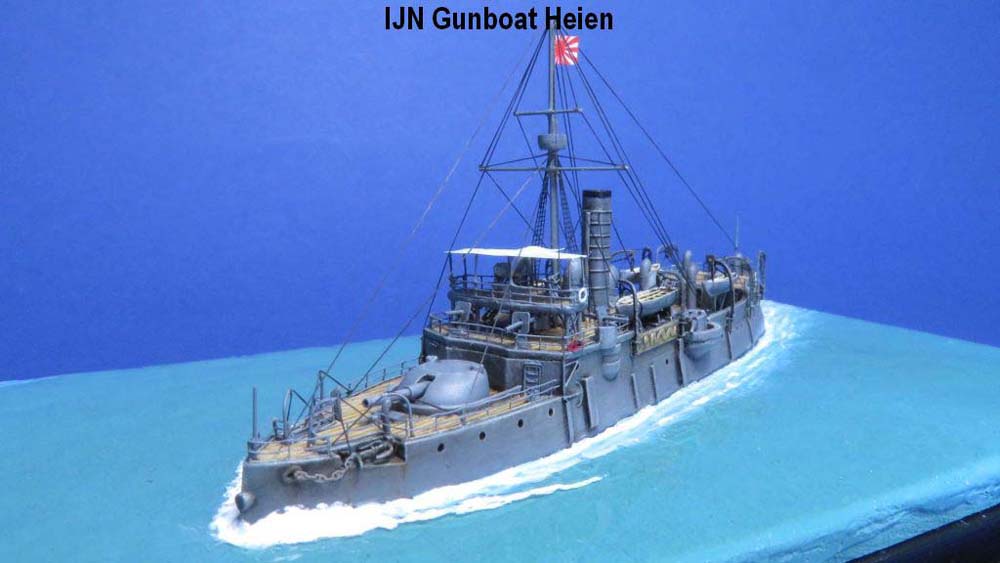
1/700 IJN Takao and IJN Heien (Combrig)
|
by Christian Höltge |

1/700 IJN Takao and IJN Heien (Combrig)
08.02.1904 - 115 years beginning of the Russo-Japanese War115 years ago, on February 8, 1904, the Russo-Japanese War began. The ships used during the war on the Japanese side included the Gunboat Heien and the unprotected Cruiser Takao.
The models of the Heien and the Takao represent the ships during the siege of Port Artur in 1904 in the Russo-Japanese War. Since both ships are quite small, I have shown them together on a water surface.
The original: Gunboat Helen
The Heien was built as Pingyuan in Foochow Arsenal, Mawei in China. The launching was 1888 and the completion in 1890. It was built as a cannon boat and therefore had a correspondingly large main gun with 26 cm. In addition, the Pingyuan was equipped with two 15 cm guns, eight machine guns and four torpedo tubes. As part of the Beijing Fleet, the Pingyuan participated in the Battle of Yalu in 1898 in the Japan-China War. It was then captured by the Japanese during the siege of Weihaiwei and immediately used under a new flag. After the war, the Pingyuan was reclassified as a gunboat and renamed Heien. During the Russian-Japanese War, it was used along with the coastal armored ship Fuso and other gunboats in the VII Division and was part of the blockade of Port Artur. After the battle in the Yellow Sea, the operations were stopped with larger ships, as the area around Port Artur was heavily mined. Among the left behind Japanese units was the Heien. She was assigned to the siege units on September 9, 1904. On September 18, the Heien was hit by a mine and severely damaged. She sank in the following heavy storm.
The original: Unprotected cruiser Takao
The Takao was an unprotected cruiser and was mainly used as Aviso to transmit messages or as a reconnaissance ship. The design was made under the guidance of a French expert and the ship was built in Yokosuka shipyard. Although many components were imported, this was one of the first steps on the way to becoming a shipbuilding industry in Japan. The launching was on 15 October 1888 and the completion on 16 November 1889. The design followed the French idea of ??a light but heavily armed ship. The armament consisted of four 15 cm cannons from Krupp and one each 6-pounder and one 12 cm ship gun. In addition came two quad Nordenfelt rifles and two torpedo tubes. So the Takao took part in the Japanese-Chinese War and protected mainly troop transports. It was overhauled in 1901, whereby the rigging was simplified and the armament was modernized. She received four 15.2 cm Armstrong and two 3-pounder Hotchkiss guns. During the Boxer Rebellion, the Takao was again responsible for securing troop transport, as well - although technically obsolete - in the Russo-Japanese War. Also at the Battle of Tsushima the Takao was part of the Japanese fleet. Due to the advent of the new wireless technology, however, it was superfluous as Aviso and deleted on April 1, 1911 from the Marineregister.
The model: the Heien
The kit comes from the Russian small series manufacturer combrig, which further complements his kit of ships from the Russo-Japanese War with the Heien. (Since the Heien wasn`t rebuilt after the Japanese takeover, you could also build the original Pingyuan from the model.) The model is made out of resin and is well detailed. I only added doors and the rear ensignia, which unfortunately was missing. Furthermore, I used etched railings and ladders. The davits are only made of Resin and I replaced them with those from 5Star Model. The masts must be built according to the template in the construction manual. I built these from brass tube. The shrouds come from Ocean Spirit and are perfect for the kit. The model is painted with Tamiya and Vallejo colors.
The model: the Takao
The Takao is also a resin kit from Kombrig. The model is well detailed and was very easy to build. With the enclosed armament, however, the Takao can only be built after the reconstruction of 1901. As with the Heien, I added the doors and used Ocean Spirit shrouds and etched railings and companionways. The davits were made of wire and the brass tube masts. The model was painted with the same colors as the Heien.
